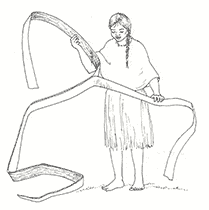The Kwakwaka’wakw were surrounded by a wealth of natural resources. The sea life, particularly the salmon, the oolichan and the cedar tree are among the resources in the natural environment that have long made the Kwakwaka’wakw both spiritually and materially rich. For the Kwakwaka’wakw the “good life” is not only about plenty of food and resources, but also about how they have used the resources, how they express their connections to living things and their appreciation of those things that sustain them.
The Kwakwaka’wakw believe that animals, rivers, and trees are powerful beings that long ago existed in both the human world and the spirit world. The Kwakwaka’wakw believe that their wealth, which comes from their surroundings, is a result of their connection to the spirit of all things.
The cedar tree is considered the “tree of life” by the Kwakwaka’wakw. Each part of the tree; roots, bark, wood, and branches were used to make an abundance of valuable resources which sustained the Kwakwaka’wakw since the beginning of time. Items made from the wood of the cedar tree were; canoes, Bighouses, totem poles, storage and cooking boxes were made from steamed wood that was bent. Baskets, mats, clothing and cedar bark regalia were made from the inner bark of the cedar tree. The branches and roots were also made into baskets and the roots were also used for sewing together bent boxes that were used for cooking.
When gathering the bark in the spring time when the sap was running, words of thanks (which some people call prayer) were always said to the trees. These words would thank the tree for giving of its bark to help make life easier for the community. It was believed that without this giving of thanks natural resources could be taken away.

After words of thanks are given to the cedar tree, a cut would be made at the base of the tree and the bark would be pulled off the tree. This drawing shows a woman in a cedar skirt and cape separating the rough outer bark from the much used inner bark.